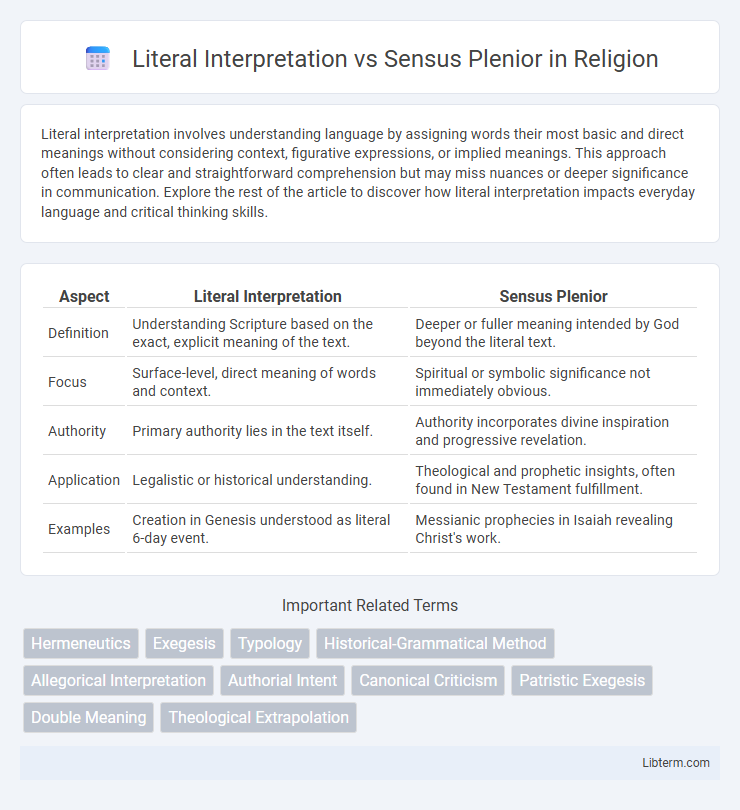Literal interpretation involves understanding language by assigning words their most basic and direct meanings without considering context, figurative expressions, or implied meanings. This approach often leads to clear and straightforward comprehension but may miss nuances or deeper significance in communication. Explore the rest of the article to discover how literal interpretation impacts everyday language and critical thinking skills.
Table of Comparison
| Aspect | Literal Interpretation | Sensus Plenior |
|---|---|---|
| Definition | Understanding Scripture based on the exact, explicit meaning of the text. | Deeper or fuller meaning intended by God beyond the literal text. |
| Focus | Surface-level, direct meaning of words and context. | Spiritual or symbolic significance not immediately obvious. |
| Authority | Primary authority lies in the text itself. | Authority incorporates divine inspiration and progressive revelation. |
| Application | Legalistic or historical understanding. | Theological and prophetic insights, often found in New Testament fulfillment. |
| Examples | Creation in Genesis understood as literal 6-day event. | Messianic prophecies in Isaiah revealing Christ's work. |
Introduction to Biblical Hermeneutics
Literal interpretation in biblical hermeneutics involves understanding the text based on its plain, direct meaning, emphasizing grammatical and historical contexts. Sensus plenior, or "fuller sense," recognizes a deeper, divinely intended meaning beyond the literal text, often revealed through the fulfillment of prophecy or typology in the New Testament. Effective biblical hermeneutics balances literal exegesis with an awareness of sensus plenior to uncover the multifaceted truths within Scripture.
Defining Literal Interpretation
Literal interpretation involves understanding biblical texts based on the plain, grammatical, and historical meaning of the words as intended by the original authors. This method prioritizes context, syntax, and lexical meaning without inferring deeper or hidden layers beyond the explicit message. It contrasts with sensus plenior, which seeks fuller meaning intended by God that may transcend the human author's immediate understanding.
Understanding Sensus Plenior
Sensus plenior refers to the deeper or fuller meaning intended by God but not fully grasped by the human author of a biblical text, distinguishing it from a strict literal interpretation that relies solely on the text's explicit meaning. This theological concept emphasizes uncovering layers of divine intent revealed through later biblical writings, prophetic fulfillment, and the broader canonical context. Understanding sensus plenior enhances biblical exegesis by acknowledging the Spirit-guided development of Scripture's ultimate message beyond its immediate historical setting.
Historical Development of Both Approaches
Literal interpretation, rooted in early biblical scholarship, emphasizes the direct, historical, and grammatical meaning of the text, gaining prominence during the Protestant Reformation as a reaction against allegorical readings. Sensus plenior, meaning "fuller sense," emerged in 20th-century biblical hermeneutics, especially within Catholic theology, highlighting the deeper, divinely intended meaning beyond the literal text as revealed through the guidance of the Holy Spirit. The historical development of these approaches reflects ongoing debates over authorial intent, scriptural inspiration, and the balance between historical context and theological depth in biblical interpretation.
Key Differences Between the Methods
Literal interpretation strictly adheres to the explicit meaning of the biblical text, emphasizing the original language and historical context to derive its message. Sensus plenior recognizes a deeper, fuller meaning intended by God that may surpass the human author's understanding, often revealed through later scriptural revelation or theological insight. The key difference lies in literal interpretation's focus on the text's surface meaning, while sensus plenior uncovers an expanded spiritual significance beyond the literal words.
Theological Implications of Literal vs Sensus Plenior
Literal interpretation confines biblical texts to their direct, historical meaning, emphasizing authorial intent and contextual accuracy, which supports doctrinal clarity and consistent theological application. Sensus plenior acknowledges deeper, divinely intended meanings beyond the literal text, allowing for expanded theological insights and prophetic fulfillment that enrich Christian doctrine. This distinction affects hermeneutics by balancing respect for scriptural literalism with openness to multifaceted divine revelation, shaping doctrinal development and interpretive frameworks.
Major Proponents and Critics
Literal interpretation, championed by figures such as John Calvin and R.C. Sproul, emphasizes adhering strictly to the explicit meaning of biblical texts, asserting that scripture should be understood in its plain, grammatical, and historical context. In contrast, the concept of sensus plenior, advocated by scholars like Origen and modern theologian Gleason Archer, suggests that scripture can convey a fuller, divine meaning beyond the literal sense, often revealed through the entirety of biblical canon or through Christocentric fulfillment. Critics of literal interpretation argue it can ignore deeper theological nuances, while opponents of sensus plenior caution against speculative readings that may stray from the original intent and become overly subjective.
Case Studies in Scriptural Interpretation
Case studies in scriptural interpretation reveal that literal interpretation adheres strictly to the explicit meaning of biblical texts, emphasizing historical and grammatical contexts. In contrast, sensus plenior embraces a deeper, divine intention beyond the literal sense, often supported by New Testament fulfillment of Old Testament prophecies. Examples include the Messiah prophecies in Isaiah, where literal readings focus on immediate historical events, while sensus plenior links these passages to Christ's incarnation and redemptive mission.
Contemporary Debates and Challenges
Contemporary debates about Literal Interpretation versus Sensus Plenior emphasize the tension between strict textual readings and recognizing deeper, divinely intended meanings beyond the surface text. Scholars challenge traditional literalism by arguing that Sensus Plenior allows for richer theological insights, especially in biblical prophecy and typology. This tension influences modern hermeneutics, prompting critical questions about authorial intent, reader response, and the role of divine inspiration in scriptural interpretation.
Conclusion: Finding Balance in Interpretation
Literal interpretation grounds understanding in the text's explicit meaning, ensuring clarity and consistency in biblical exegesis, while sensus plenior uncovers deeper, divinely intended significance beyond the literal words. Effective theological analysis requires balancing these approaches to respect the original context and embrace fuller spiritual insights. Integrating literal and sensus plenior interpretations enriches scriptural comprehension and supports nuanced doctrinal applications.
Literal Interpretation Infographic

 libterm.com
libterm.com